The Museo Universitario Arte Contemporáneo (MUAC) in Mexico City removed works by the Argentine artist Ana Gallardo that included offensive statements and slurs about older former sex workers.
The curatorial team initially limited access to the works following a letter of concern from Casa Xochiquetzal, the shelter for unhoused former sex workers in Mexico City that Gallardo visited for the project in question. Later, after advocates protested outside the museum and graffitied its facade with messages in support of sex workers, MUAC withdrew the works and issued an apology.
Gallardo’s solo exhibition, Tembló acá un delirio, opened at MUAC on August 10. The show swiftly drew criticism from activists, artists, and advocates for the sex worker community, in particular over the artwork “Extracto para un fracasado proyecto (2011–2024)” (“Extract for a failed project 2011–2024”), which consists of a monumental text etched by Gallardo directly onto a wall at the museum. Written haphazardly without punctuation and in the first person, the paragraph recounts Gallardo’s alleged attempt to collaborate with sex workers in a “nursing home for women prostitutes” and “old street whores.”
Among the offending lines are derogatory characterizations of an older sex worker named Estela, described by Gallardo as an “old sick whore” whom she was asked to care for.
Last week, Casa Xochiquetzal sent a letter to exhibition co-curator Alejandra Labastida denouncing Gallardo’s text, refuting her account of caring for Estela, and accusing the artist of photographing the woman without her consent.
“Ana Gallardo uses the word ‘whore’ and the expression ‘daughter of a whore’ as insults on multiple instances. These already constitute misogynistic slurs, but they become even more concerning when used specifically against Casa Xochiquetzal, its former director, and its residents,” reads the letter, which the organization shared in Spanish on Facebook.
“Ana Gallardo disrespects the identity of the house’s residents, discloses Estela’s name, records her and displays her, records and displays the outside of the house, lies, defames, insults, re-victimizes, attacks, impacts the women, and all of this using public funds and with MUAC’s approval,” the letter continues. The organization also claimed that Gallardo never returned after her one day onsite, refuting the artist’s account of “returning to care for” Estela in the mural text.
Gallardo declined Hyperallergic’s request for an interview via Ruth Benzacar, the Buenos Aires gallery that represents her.
Casa Xochiquetzal was founded in 2006 as a residence for unhoused women who are former sex workers. The organization offers residents medical and mental healthcare, leisure activities, food, shelter, and “all that is needed for a dignified life and death in spite of the conditions that they face at this age, and at the end of a difficult life,” their statement reads.
MUAC first responded to the organization’s letter with a statement on October 10 explaining that Gallardo’s work “alludes to the frustration she experienced, from her personal perspective, but also to learning about the limits of artistic work to address certain issues.” Two days later, the museum said it had restricted access to “Extracto” while the exhibition underwent a review.
On October 15, museum leadership announced the decision to remove the wall piece and another artwork, “Sin título, 2011,” from the exhibition altogether after protesters from groups including Alianza Mexicana de Traajadorxs Sexuales (AMETS) and LLECA-Escuchando la calle rallied at MUAC throughout the weekend. Activists spray-painted messages on its facade demanding “respect and rights for all sex workers” and calling the museum “whorephobic” — a term used to describe ongoing prejudice, stigma, discrimination, and violence toward those in the sex industry. Another graffiti described Gallardo as White and privileged.

In its most recent statement, MUAC said the museum and curatorial team “recognize a significant failure and offer an apology to the people offended.”
The museum said that in its decision to display the work, it did not consider that it would be “offensive to those who support the Casa Xochiquetzal, to the community of activists advocating for sex workers, and to a broad sector of the public who is concerned about the danger of extractivism in contemporary cultural practices.”
“The fact that the works caused offense is contrary to the purpose of the curatorial project, to the intentions of the artist and the institution,” it continues.
In a separate statement, the Universidad Nacional Autónoma de México, under which MUAC operates, stated that it is “against all violence against people and especially women and historically vulnerable groups.”
MUAC clarified that a public forum regarding the exhibition and its criticisms is forthcoming and open to anyone interested.

